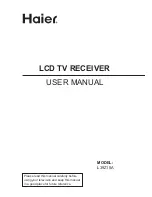
10
considerable interference is present at the location where the receiving equipment has to be
installed, the antenna should be moved to a position with lower interference. Also the use of a
directional antenna (see
Appendix E
) can be considered. Transmission range of the DWR-G
0.4m is less: line of sight with a handheld receiving antenna and 25 Km with a ground plane
antenna.
Installing the antenna cable
The length of the antenna cable is not critical as long as a good quality coaxial cable is used.
The supplied RG 213 cable has an attenuation of 3.5 dB/100m allowing up to 200m of cable
lengths. However, shorter cable lengths are always preferred to improve the signal to noise
ratio. Especially in signal limited situations (where signals of buoys at the edge of the normal
range must be received) the cable should be no longer than strictly necessary. Install the coaxial
cable without stretching or bending and avoid mechanical stress. With respect to routing there
are few restrictions. Although the cable is screened and not very sensitive to surrounding
electric or magnetic fields and disturbances, try to avoid routing the cable directly along power
cabling.
Be aware of the fact that reception in most areas is limited by local noise and interference. It
pays to install the antenna in such a way that distance to local sources of noise and interference
is maximized. In these situations, it is entirely acceptable to use a longer cable in order to install
the antenna further away from a source of interference.
Using a directional antenna
In case of weak signal and/or high local noise or interference the use of a directional antenna
can be considered. The sensitivity of such an antenna is 3 dB higher in the direction of the buoy.
Interference and noise generated at the landside will be attenuated by 6 dB. The combination of
gain at the frontside (thus towards the buoy) and suppression of noise from the backside of the
antenna will improve the signal to noise ratio.
Using an antenna splitter
For connecting multiple receivers to a single antenna, the Datawell Antenna Splitter can be
used. This device is optimized for the buoy reception frequencies and signal levels. With the
Datawell Antenna Splitter up to six receivers can be used with a single antenna.
3.3 Connecting the serial output to a PC
Connection of the serial output to a PC is done using a standard D-SUB RS232 cable assembly.
The receiver has a nine pin D-SUB outlet of which only pins 2 and 3 carry active signals. Pin 5
is signal ground. Normal RS232 cable length restrictions apply. RS232 ports are becoming
scarce on PC’s, in favour of USB ports. This problem may be solved with a RS232-USB serial
adapter. However, some adapter models do not offer the same data transmission reliability as
RS232 serial connections do.
3.4 Grounding
For correct reception of buoy signals grounding of the antenna is not necessary. The supplied
ground plane antenna takes care of its own RF reference. Also grounding of the receiver and/or
connected computer is not a remedy for all kind of noises and disturbances. Noise and trouble
free reception should be possible without any connection or reference to ground.
However from a viewpoint of safety it is recommended to connect the receiver to a safety
ground. Normally the three wire power cord will take care of this.
Содержание 45100
Страница 2: ...2 Check if mains supply matches with the specifications of the device...
Страница 4: ...4...
Страница 6: ...6...
Страница 8: ...8...
Страница 12: ...12...
Страница 20: ...20...
Страница 34: ...34 Appendix E Receiving antennas E 1 Standard groundplane antenna Figure E1 Standard groundplane antenna...
Страница 36: ...36 E 2 Directional Antenna 25 45 MHz Figure E3 Directional quarter wave antenna...











































